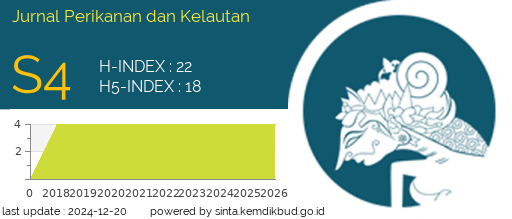Comparative Study of Growth Circle Patterns in Otoliths of Guppy Fish (Poecilia reticulata) from Areas Polluted with Domestic Sewage
DOI:
https://doi.org/10.31258/jpk.30.2.275-281Keywords:
Dark Ring, Polluted Water, Ditch, Fish GrowthAbstract
Guppy fish (Poecilia reticulata) inhabit polluted water, such as domestic waste-filled ditches in residential areas, as well as in rivers. These two habitats have different water qualities, which affects the growth of the fish; this is reflected in the pattern of growth rings in the otoliths. To determine the differences in growth ring patterns of otoliths in guppies living in ditches versus the river, a study was conducted in March and April 2025. Fish were caught using a scoop net once every 2 weeks, three times. The fish were measured, and otoliths were taken. They were then attached to objects made of glass and manually shaved using a smooth grindstone. The growth rings in the otolith were observed using a microscope. Results showed that 103 fish were caught, 50 from the trench and 53 from Tangkerang River. The size of the fish caught was 18-31 mm from the trench and 17-31 mm from the river. In fish with the same total length, the otoliths from the river were longer and wider (0.5-1 mm in length and 0.4-0.95 mm in width), whereas those from the trench were shorter (0.42-0.85 mm in length and 0.4-0.67 mm in width). The maximum number of dark rings on the otoliths of fish from the ditch was 3, whereas from the river, it was 4. There were 27 fish from the river and 18 fish from the trench that had no dark ring in the otolith. The data obtained show that the growth of guppies in the Tangkerang River is better than in the Purigiam Housing trench
Downloads
References
Dua, V.K., Pandey, A.C., Rai, S., & Dash, A P. (2007). The larvivorous activity of Poecilia reticulata against Culex quinquefasciatus Larvae in a Polluted Water Drain in Hardwar, India. Journal of the American Mosquito Control Association, 23(4): 481-483.
Effendie, M.I. (2006). Biologi Perikanan. Yayasan Pustaka Nusantara. Yogyakarta. 162 p.
Faisol, A., & Wahid, A. (2022). Penerapan Internet of Things (iot) untuk Monitoring dan Controlling pH Air Suhu Air dan Pemberian Pakan Ikan Guppy pada Aquarium menggunakan Aplikasi Whatsapp. JATI (Jurnal Mahasiswa Teknik Informatika), 6(1): 276-284.
Kordi, G.H. (2004). Penanggulangan Hama dan Penyakit Ikan. PT. Sadi Mahasatya. Jakarta. 194 p.
Lawal, M.O., Edokpayi, C.A., & Osibona, A.O. (2012). Food and Feeding Habits of the Guppy, Poecilia reticulata, from Drainage Canal Systems in Lagos, Southwestern Nigeria. West African Journal of Applied Ecology, 20(2): 1-9.
Leguá, J., Plaza, G., Pérez, D., & Arkhipkin, A. (2013). Otolith Shape Analysis as a Tool for Stock Identification of the Southern Blue Whiting, Micromesistius australis. Latin American Journal of Aquatic Research, 41(3): 479-489.
Lubis, Z.M. (2014). Pengaruh Aklimatisasi Kadar Garam terhadap Nilai Kematian dan Tingkah Laku Ikan Guppy (Poecilia reticulata) sebagai Pengganti Ikan Cakalang (Katsuwonus pelamis). Departemen Ilmu dan Teknologi Kelautan. Institut Pertanian Bogor.
Montag, L.F.D.A., Freitas, T.M.D.S., Raiol, R.D.D.O., & Silva, M.V.D. (2011). Length-Weight Relationship and Reproduction of the Guppy Poecilia reticulata (Cyprinodontiformes: Poeciliidae) in Urban Drainage Channels in the Brazilian city of Belém. Biota Neotropica, 11: 93-97.
Popper, A.N., & Fay, R.R. (2011). Rethinking Sound Detection by Fishes. Hear. Res., 273: 25–36.
Salmin, S. (2005). Oksigen Terlarut (DO) dan Kebutuhan Oksigen Biologi (BOD) sebagai Salah Satu Indikator untuk Menentukan Kualitas Perairan. Oseana, 3: 33–34.
Santos, J.M., & Ferreira, M.T. (2020). Use of Aquatic Biota to Detect Ecological Changes in Freshwater: Current Status and Future Directions. Water, 12(6): 1611.
Schulz-Mirbach, T., Riesch, R., De León, F., & Plath, M. (2011). Effects of Extreme Habitat Conditions on Otolith Morphology: A Case Study on Extremophile Live Bearing Fishes (Poecilia mexicana, P. sulphuraria). Zoology, 114(6): 321-34.
Shah, T.K., Saini, V.P., Ojha, M.L., & Raveender, B. (2017). Effect of Temperature on Growth and Survival of Guppy (Poecilia reticulata). J. Exp. Zool. India, 20(1): 505-510.
Siahaan, L.J. (2021). Pola Lingkaran Pertumbuhan Otolith pada Ikan Barau (Hampala macrolepidota Khul & Van Hasselt, 1823) di Danau Teluk Petai Kabupaten Kampar Provinsi Riau. Universitas Riau.
Siregar, R.A. (2018). Analisis Isi Lambung Ikan Baung (Mystus nemurus) di Rawa Banjiran Sungai Air Hitam Kecamatan Payung Sekaki Kota Pekanbaru Provinsi Riau. Fakultas Perikanan dan Ilmu Kelautan Universitas Riau.
Stransky, C., Murta, A.G., Schlickeisen, J., & Zimmermann, C. (2008). Otolith Shape Analysis as a Tool for Stock Separation of Horse Mackerel (Trachurus trachurus) in the Northeast Atlantic and Mediterranean. Fisheries Research, 89(2): 159-166.
Sudjana, S. (2006). Metode Statistik. Jakarta: Rineka Cipta. 487 p.
Windarti, W., & Simarmata, A.H. (2017). Buku Ajar Histologi. UR Press. Pekanbaru. 105 p.







